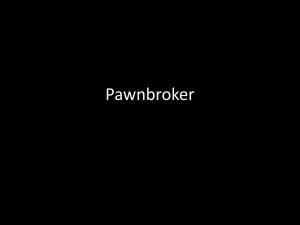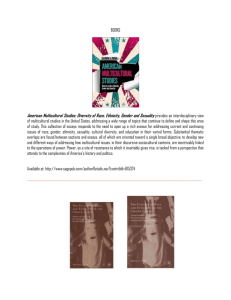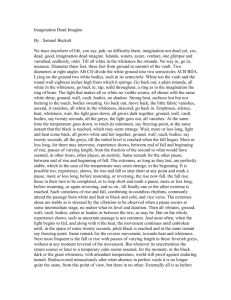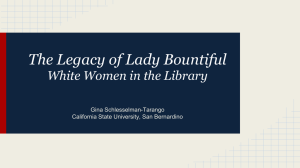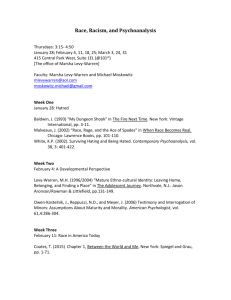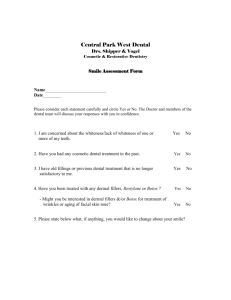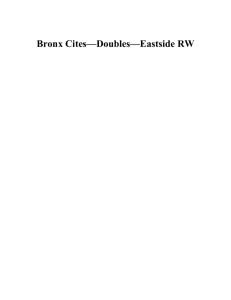Slides
advertisement
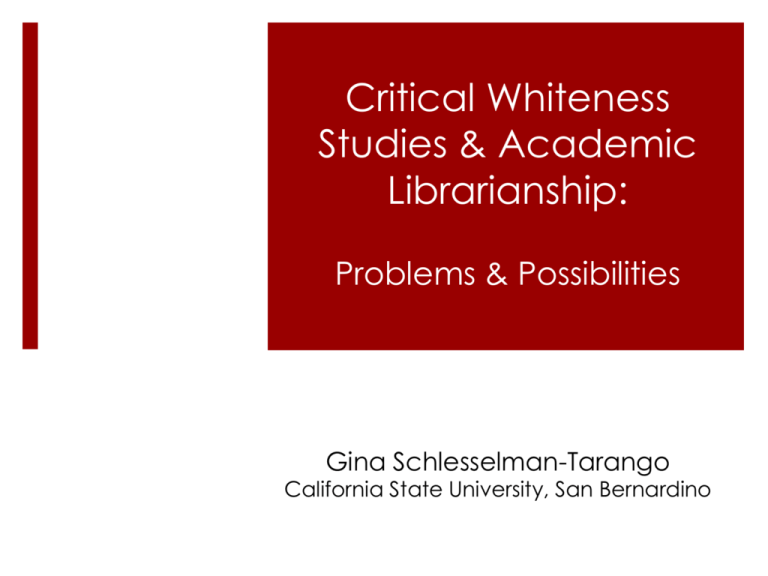
Critical Whiteness Studies & Academic Librarianship: Problems & Possibilities Gina Schlesselman-Tarango California State University, San Bernardino What is Critical Whiteness Studies (CWS)? McIntosh, 1988 (white privilege) & Morrison, 1992 (Playing in the Dark) Aim: Make visible that which is invisible Whiteness is: Debates in the Field Abolitionism “Race traitor” (Ignatiev et al.) vs Reconstructionism (Giroux, et al.) Reinventing whiteness “Missing is an argument that not only includes participation by people of color, but begs the question of how they are affected by a nearly all-White strategy. Arguably staying with what they know best, Whiteness Studies educators speak to their own racial formation as Whites. But this is incomplete at best and reinforces the invisibility of people of color at worst.” (Leonardo, 2013, p. 110) Debates in the Field Particularities of whiteness How whiteness intersects with class, gender, age, etc. “White trash,” minoritized or disadvantaged whites Critique Divests whites of responsibility or complicity “Appropriates language of racial oppression” (Nguyen, 1998) Criticisms of CWS • What’s new about it? • Centering of whiteness • Prevalence of personal testimony “White liberal guilt at its most performative has the…effect of diverting attention from the facts of white racism and oppression to how badly the Enlightened White Liberal feels about it.” (López, 2005, p. 23) • What about racism? What about people of color? Whiteness in LIS Literature Espinal, 2001: calls for application of whiteness theory Whiteness in LIS History Public libraries & racial projects (Honma, 2005) Enlightenment values and white supremacy (de jesus, 2014) White women librarians as colonizing agents (Schlesselman-Tarango, under review) Children’s lit and white supremacy in the US South (Hand, 2012) Whiteness in LIS Literature • Whiteness in contemporary libraries/LIS • White privilege (Berry, 2004) • White awareness of racism in LIS (St. Lifer & Nelson,1997; Alabi, 2015) • LIS epistemology (Honma, 2005) • Exnomination of whiteness (Hussey, 2010) • LIS education (Pawley, 2006) Additional Areas of Exploration • Contemporary postcolonial, neocolonial, neoliberal projects & white savior complex • Prevalence of white women in the field: How is femininity used to attempt to neutralize the violence of white supremacy? • Whiteness in information description & organization • How is whiteness invested in and protected at expense of people of color: higher education, institutional racism • How do whites preserve and rationalize their power? • White behaviors, actions in academic libraries • LIS curricula, language, mission of academic libraries • Spaces and places (physical & virtual) • What does whiteness look like in all-white settings? Suggestions Moving Forward Maintain a critical approach Expose connections between whiteness and racism, injustice Do not fetishize whiteness Trouble it Remain engaged with & aware of tensions Ask the difficult questions Don’t rely on CWS in isolation Womanism, feminism, queer and disability theory, etc. References Alabi, J. (2015). Racial microaggressions in academic libraries: Results of a survey of minority and non-minority librarians. The Journal of Academic Librarianship, 41(1), 53. doi:http://dx.doi.org/10.1016/j.acalib.2014.10.008 47- Andersen, M. (2003). Whitewashing Race: A Critical Perspective on Whiteness in A. W. Doane & E. Bonilla-Silva,(Eds.), White out: The continuing significance of racism (21-34). New York: Routledge. Berry, J. D. (2004). White privilege in library land. Library Journal-New York, 129, 50. Bourg, C. (March 3, 2014). The unbearable whiteness of librarianship. Retrieved from https://chrisbourg.wordpress.com/2014/03/03/the-unbearable-whiteness-of-librarianship/ de jesus, n. (2014). Locating the library in institutional oppression. In the Library with the Lead Pipe, September. Retrieved from http://www.inthelibrarywiththeleadpipe.org/2014/locating-the-library-in-institutional-oppression/ DiAngelo, R. (2012a). Nothing to add: The role of white silence in racial discussions. Journal of Understanding and Dismantling Privilege, 2(2), 1-17. DiAngelo, R. J. (2012b). What does it mean to be white?: Developing white racial literacy. Peter Lang New York, NY. Doane, A. W.. (2003). Rethinking Whiteness Studies in A. W. Doane & E. Bonilla-Silva,(Eds.), White out: The continuing significance of racism (3-18). New York: Routledge. Espinal, I. (2001). A new vocabulary for inclusive librarianship: Applying whiteness theory to our profession. In L. Castillo-Speed & REFORMA National Conference Publications Committee (Eds.), The power of language/el poder de la palabra: Selected papers from the second REFORMA national conference (pp. 131-149). Giroux, H. A. (1997c). Rewriting the discourse of racial identity: Towards a pedagogy and politics of whiteness. Harvard Educational Review [H.W.Wilson - EDUC], 67, 285. Hand, S. (2012). Transmitting whiteness: Librarians, children, and race, 1900-1930s. Progressive Librarian, 34-63. Honma, T. (2005). Trippin' over the color line: The invisibility of race in library and information studies. InterActions: UCLA Journal of Education and Information Studies, 1(2), Article 2. Hudson, D. (2012). Unpacking "information inequality": Toward a critical discourse of global justice in library and information science. Canadian Journal Information & Library Sciences, 36(3), 69-87. Hussey, L. (2010). The diversity discussion: What are we saying? Librarian, 34(35), 3. Ignatiev, N. (1997). The point is not to interpret whiteness but to abolish it. Talk given at the Conference “The Making and Unmaking of Whiteness” University of California, Berkeley, April 11-13, 1997 . Retrieved from http://racetraitor.org/abolishthepoint.pdf Leonardo, Z. (2013). Race frameworks: A multidimensional theory of racism and education. New York: Teachers College Press. Levine-Rasky, C. (2012). Working through whiteness: International perspectives. Albany: SUNY Press. López, A. (2005). Postcolonial whiteness: A critical reader on race and empire. Albany: SUNY Press. McIntosh, P. (1992).White privilege: Unpacking the invisible knapsack. Multiculturalism, 30-36. Morrison, T. (1992). Playing in the dark. Cambridge, Mass.: Harvard University Press. Nguyen, M. T. (1998). Mimi Nguyen: Introduction in Evolution of a race riot #1. Retrieved from http://issuu.com/poczineproject/docs/evolution-of-a-race-riot-issue-1 Pawley. (2006). Unequal legacies: Race and multiculturalism in the LIS curriculum. The Library Quarterly, 76(2), 149-168. Schlesselman-Tarango, G. The legacy of lady bountiful: White women in the library (under Review). St Lifer, E. & Nelson, C. (1997). Unequal opportunities: Race does matter. Library Journal, 122(18), 42-46. Wiegman, R. (1999). Whiteness studies and the paradox of particularity. Boundary 2, 26(3), 115. of

